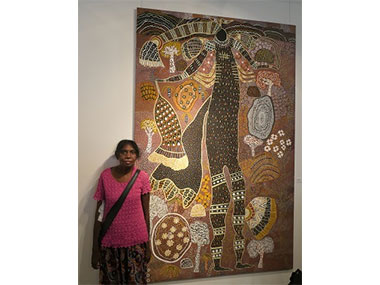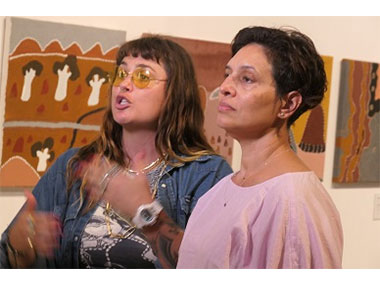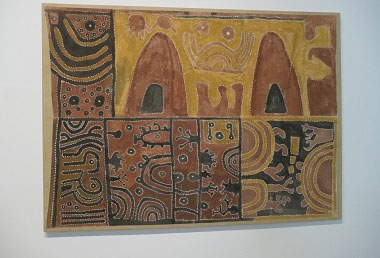THE WEST

Batty Bundamurra beside her Kira Kiro painting featuring the hero Penda Gudje at Mosenson Art Gallery in Perth
Posted by Jeremy Eccles | 26.02.19
Gallery: Art Gallery of WA
Dates:
09.02.19
: 27.05.19
The West is another country – its deserts and Kimberley wilderness, wheatlands and wineries, two huge areas of mining, and a capital city built on sand that's on the edge of overcoming the feeling that it could be deserted at any time (as Tim Flannery once predicted).
It also has a greater level of Indigenous influence than any other State – from Kulumburu at the top to Esperance at the bottom. For many of us, Kimberley and Canning Stock Route desert art provides the images that are most familiar to us from the West. And sometimes one wonders whether other West Australians bother at all about what we think of them 'Over East' – as they casually dismiss us.
But right now, at home in Perth, it's perfectly obvious that levels of State patriotism are mighty strong. They once had a really successful national Indigenous art prize – it had 6 iterations - selecting major artists from as far away as the Torres Strait right back home to the West (which had its own local prize), and getting them to select a group of their works in competition. A strong point of difference to the Telstras in Darwin, which takes only a single work from each artist. But the State government dropped its funding for that. It really hadn't promoted it anyway on the national basis that it deserved. In its place came the totally WA project, 'Desert River Sea', whose final exhibition has just opened.
As one-time Art Gallery of WA curator Clothilde Bullen puts it in the catalogue, “In 2010, I and the leadership team set out to create a focus on Western Australian Aboriginal art and to enhance the already substantial collection (at AGWA) of works from the Kimberley region”.
Could this have been partly because there'd been much collecting by the likes of Michael O'Ferrall when Rover Thomas and Queenie Mackenzie burst on to the scene in the 80s? But follow-up by his successors may have been distracted by more local art activity in Perth from artists such as Shane Pickett, Julie Dowling and Sandra Hill, and the rediscovery of Carrollup pioneer, Bella Kelly. As Bullen suggests, “Two generations of (Kimberley) artists have since commenced their artistic journeys”, but not been seen in Perth.
Now they're there in spades. And not just their art; 60 artists and art centre curators were funded to come from The Kimberley to see their works installed – even to help install canvases, films and installations. For, this wasn't a simple art exhibition. It was a 6-year exercise in both community empowerment and an attempt to find new ways of dealing between institutions like AGWA and remote artists and their organisations.
Having raised $1.8m from Rio Tinto, it began with internships for art centre workers which would prepare them for the important online presence that 'Desert River Sea' has given to Kimberley art. Works for that archive would be selected by communities and both subject descriptions and artist profiles have been added to the comprehensive collection now online. These trainees would go on to be involved in the negotiation of commissions from each of the six art centres (sadly, Bidyadanga has lost so many of its senior artists, it failed to put in a bid), and from three independent artists, Bidyadanga's Daniel Walbidi and Lombardina's Sibisado brothers, Garry and Darrell. They'd then come to Perth to see the works placed in the Gallery. And finally, at least for journalists at the opening, the interns were on hand to talk about their community's work.
As AGWA's current Indigenous Art curator, Carly Lane explains, “We don't have trainees moving into art centre management yet, but they are taking curatorial roles outside their art centres. We're also really happy that they now have the confidence to talk about their art; they can now direct the national conversation”.
Heavily involved in this side of the project was the Aboriginal Art Centre Hub of WA – the WA equivalent of Desart, ANKA or the Indigenous Art Centre Alliance in Queensland. It helped that Bardi man Chad Creighton – now ACHWA's CEO - was an intern himself at AGWA at the beginning of all this and he was involved in suggesting a project that mapped the Songlines of The Kimberley. “But there were issues with that”, he admitted. “So I had the widest range of conversations on visits to communities and returned with the current project. They didn't want to fit into a single theme but preferred a survey allowing the artists to define its shape”. It must have helped that he'd also been practising politics on Native Title claims with the Kimberley Land Council.
Oddly, though, ACHWA's membership doesn't yet extend into The Kimberley apart from a textile workshop in Broome. Its art centres are newer and further south in the Pilbara, Port Hedland, gold-mining Leonora and the Martu Lands – for ANKA has covered The Kimberley for some 35 years. But Creighton tells me that Warakurna and Tjarlirli – desert centres on the NT border have joined recently (I wonder if they've left Desart?) and there have been meetings at Waringarri in Kununurra. As Creighton also tells me that ACHWA is pursuing funding from the WA Government, and he made great play of the tourist potential of the art centres in The Kimberley in his opening night speech, it seems more than possible that he'll be aiming for statewide representation before too long.
Will ANKA and Desart fight or share their responsibilities, I wonder?
Barely behind the scenes in much Aboriginal art and an equal amount of non-Indigenous creation is a unique body that other States might take a close look at – Form. It operates to initiate and support arts projects across the southern part of this vast State, somewhat like an imaginative and proactive Arts Ministry off-shoot.
With 30 staff, Form supported the vast Canning Stock Route 'Yiwarra Kuju' project that came to the National Museum and the Australian Museum Over East (but, oddly, wasn't seen in the West). It's working on a brave effort to take Tjanpi Desert weaving into the theatre with Polyglot puppet theatre – spending three years in and out of the deserts to get the protocols right. 'Manguri Wiltja' opens in Fremantle on 13 April. Spinifex Hill art centre in the Pilbara invited Form to “take them further” when it seemed to be failing. And Kunawarritji woman Bugai Whyoulter gets her first solo appearance in Perth at The Goods Shed, a repurposed railway workshop where Form has a public presence and cafe.
But, beyond the Aboriginal world, grain silos across the wheatlands have been painted by artists, artists and writers go into schools regularly, the Uluru 'Field of Lights' artist, Bruce Munro has created an illuminated Avenue of Honour in homage to the ANZACS who departed from the port of Albany – attracting five times as many predicted punters to the far south along a Silos Trail that starts at Northam. And public art has been commissioned from Noongar artists for Perth's Elizabeth Quay and its new Optus Stadium.
“At the core of our programming”, says Form's annual report, “is the facilitation of innovative partnerships between artists, communities and stakeholders”. Their 'Once Upon a Time in the West', project, for instance, tackled station work broadly, ranging from C&W music to a growing Aboriginal agency that's seeing more and more stations owned by their once-unpaid stockmen.
That cross-cultural history featured in 'Desert River Sea' as well. I've reviewed the show for Art Almanac magazine's April issue. But some issues stood out which I'll canvass here.
For that stockwork history was the choice of artists from Mangkaja Art Centre in Fitzroy Crossing – a mixture of desert tribes forced north by drought, mining and the pastoral industry and the local Bunuba and Gooniyandi people. I have to say that the choice of real cowhides upon which to impress their stories was apposite rather than spectacularly successful as art. But the clash off the walls between the politically correct commentators in the catalogue who negatively summed up those times as 'slavery' and 'forced labour', was noteworthy. For the 'slaves' themselves wanted only to share their positive memories: such as Mervyn Street's “I really loved working there (at Udlun Station)” or Eva Nargoodah's “Station life was good. Going to school. Having fresh milk”. Even John Prince Siddon's cowhide showing himself losing a leg in a mustering accident seems to bear no grudge to his conditions of employment.
Nargoodah's clothes made from old flour bags hang beside the men's hides; with her insisting, “we used to like it wearing those clothes”, preferring things they'd made by hand themselves over hand-me-downs from the big house.
Another fascinating development that shows up black versus white interpretations of Aboriginal culture involves what used to be called Bradshaw figures. The history here fascinates me – for the notorious Grahame L Walsh did his best to prove that what are now variously called Gwion Gwion, Gyon Gyon and Kira Kiro figures by different tribes in the far north-west were the work of a superior Aboriginal group who lived in The Kimberley before the Ice Age ended, to be supplanted by a supposedly inferior group moving inland from the Arafura Plains as the waters rose.
Certainly, the Gwion figures are wildly different and more graceful than the Wandjina imagery that often over-paints them. And, maybe language groups such as the Ngarinyin, the Wunambul and the Worrora weren't initially comfortable with identifying the ancient Gwions as theirs. But 'Desert River Sea' (and the simultaneous 30th-anniversary show at the Mossenson Gallery) reveals just how completely Gwion imagery has been adopted into the art today.
Fortunately, Mowanjum and Kira Kiro art centres have chosen very different approaches to their commissions. Mowanjum has a delightful film sequence that grew from a community project to 'wake up' their youngsters to the importance of relationships between the tribe's two skin groups via the collection of the proper plant materials and ochres for ceremony, the right way to paint up and the correct clap to wake up the Wandjina. For them, the Wandjina has the supreme creative power, and he created the Gwions.
Kira Kiro Art Centre at Kulumburu, on the other hand, sees their Kiro Kiros as the creatures who established the Wunan/law, therefore far older than the Wandjinas, whom they've stayed around to protect. Serious linkages between their Kira Kiros and local landmarks suggest real continuity of a mythology, which appears heroically in the life-sized paintings of the late Mary Punchi Clement and the very active Betty Bundamurra. As Betty explained to me, “Penda Goodje was the Kwini hero from a time before the Orolo (dingo) came to Australia and he helped to defeat the two bodied monster, Malan by secretly putting giant ticks underneath him, turning it into the Malan rock, which is still there today”.
Meanwhile, the Miriwoong in the North East Kimberley surprised with their conceptual work attempting to explain something called Wirnan. It may be the philosophical justification for the distasteful habit of humbugging – for it involves a cultural obligation to give to anyone else in order to maintain your role in society and to care for the collective, not just the individual. No fewer than thirteen Waringarri Art Centre members across three generations collaborated on the project, trying to find a way to communicate this complexity without giving away closed elements of it. The point is made in the catalogue that no similar concept exists in Western society. But the Kula exchange around the Melanesian islands may well justify research by anthropologists and the Miriwoong.
For pure aesthetics, on the other hand, 'Desert River Sea' backs up the present with a multitude of historical works from its own and other Perth collection. There are riches indeed here! Listing quite randomly, I have to include an exceptional large Paddy Jaminji and two delicate carvings by George Mung Mung from Warrmun; the 1985 sandstone carving of an 'Ancestral Being's head by Big John Dodo from Bidyadanga; a mysterious conceptual painting by Peter Pijaju Skipper from Mangkaja entitled, 'Men Standing on Other Men's Shoulders'; and a devastating work from the Jirrawun collective in Kununurra called 'Tickets' – harnessing the graffiti skills of young Remike Nocketta and Desma Sampi combined with their exposure to Andy Warhol by Jirrawun boss Tony Oliver, multiplying the gruesome labels hung round their forebears' necks marking them to become victims of the Bedford Downs Massacre.
Enough on the West already. It may increasingly betray signs of its pre-Federation desire to leave the rest of Australia. But its contribution to the national picture is worth examining!
URL: http://desertriversea.com.au/art#type=art&start=0&limit=12&filter=all¶m=
Share this:
»  del.icio.us
»
del.icio.us
»  Digg it
»
Digg it
»  reddit
»
reddit
»  Google
»
Google
»  StumbleUpon
»
StumbleUpon
»  Technorati
»
Technorati
»  Facebook
Facebook
Contact Details
Gallery: Art Gallery of WA
Email: admin@artgallery.wa.gov.au
Telephone: +61 8 9492 6600
Address: Perth Cultural Centre Perth Perth 6000 WA
Gallery: Art Gallery of WA
Email: admin@artgallery.wa.gov.au
Telephone: +61 8 9492 6600
Address: Perth Cultural Centre Perth Perth 6000 WA

'Desert River Sea' curators Emilia Galatis and Carly Lane with the Warrmun contemporary canvases at in AGWA's exhibition

'Kimberley Landscape' (c1984) by Paddy Jaminji, a 2.7 metre wide work in the AGWA collection.
Where is the exhibition?
Further Research
Gallery: Art Gallery of WA
Artists: | Bella Kelly | Betty Bundamurra | Big John Dodo | Bugai Whyoulter | Daniel Walbidi | Darrell Sibisado | Desma Sampi | Eva Nargoodah | Garry Sibisado | George Mung Mung | John Prince Siddon | Julie Dowling | Mary Punchi Clement | Mervyn Street | Paddy Jaminji | Peter Pijaju Skipper | Queenie Mackenzie | Remike Nocketta | Rover Thomas | Sandra Hill | Shane Pickett
News Tags: ACHWA | ANKA | Art Gallery of WA | Bradshaw figures | Carly Lane | Chad Creighton | Clothilde Bullen | Desart | Desert River Sea | Emilia Galatis | Form | Jeremy Eccles | Mossenson Gallery | Rio Tinto | Wandjina
News Categories: Australia | Blog | Event | Exhibition | Feature | Industry | News | Other Event
Exhibition Archive
- 30.03.19 | Kunmanara Williams Stars at The National
- 27.03.19 | Parrtjima and CIAF announce 2019 plans
- 19.03.19 | Jarinyanu David Downs Collection Heads to NT
- 14.03.19 | TJUNGUNGUTJA TO ALICE
- 26.02.19 | THE WEST
- 22.02.19 | DICK ROUGHSEY IS TOPS
- 21.02.19 | 30 YEARS OF ABORIGINAL ART IN THE US
- 30.01.19 | TUCKSON AND TILLERS
- 25.11.18 | NONGGIRRNGA
- 13.11.18 | The Uluru Statement comes to Sydney
- 05.11.18 | Skye's the Limit
- 29.10.18 | MAJOR INDIGENOUS COMMISSION FOR THE ASIAN STAGE
- 17.10.18 | Tommy Watson in Sydney
- 10.10.18 | The Aboriginal Memorial – A Smouldering Reproach
- 03.10.18 | Closing the Craft Circle
Advertising

